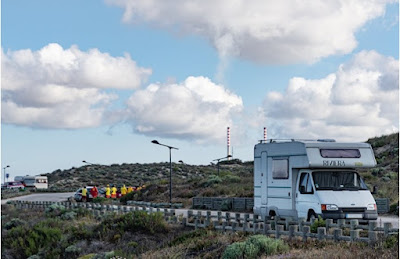All RVs have batteries, although not all RVs have the same type of batteries. More than likely, the most common types of RV batteries are flooded lead-acid and sealed-lead acid batteries. Each of these requires special maintenance to ensure optimal battery performance and extend battery life.
Flooded lead-acid batteries generally require the most maintenance. They must be charged frequently and even with regular charging, a phenomenon called “off-gassing” will occur, which will require you to refill the battery with distilled water (some owners use RV battery watering systems for this; see below).
Sealed lead-acid batteries, like gel and absorbed-glass mat (AGM) batteries, have a sealed cell that does not experience off-gassing and requires less maintenance than flooded lead-acid batteries do.
Nonetheless, all RV batteries will benefit from routine charging (or maintenance through a trickle charge), cleaning, and other TLC. Here’s what you need to know.
Keeping the Terminals Clean
Regardless of the type of battery you have, keeping the terminals clean is very important. Clean terminals can establish a more secure electrical connection which in turn ensures efficient discharge.
Over time, battery terminals will corrode, especially around the positive (red) terminal. If you notice any white, blue, or brownish flaky deposits around your battery’s terminals, clean it off right away.
To clean battery terminals, you don’t actually have to remove them from their mounts. You can simply disconnect the battery, and use a battery cleaning solution or make your own. Some guides suggest using a paste of baking soda and water.
You can use a commercially available battery terminal scrubber, or a brass or steel brush, along with this solution, to scrub your terminals clean.
After you’ve cleaned the corrosion off the terminals, it’s time to focus on the connections and leads. Clean these in the same manner, with the same solution, then wipe down the battery, terminals, connections and leads before allowing them to dry thoroughly.
Once the battery, terminals, and all connections are completely dry, you can reconnect the battery.
Keeping your RV’s battery clean of corrosion is one of the easiest things you can do to improve battery life and establish secure electrical connections. Also, dirty terminals can potentially cause shorts that prevent you from running the RV; so keep your terminals clean!
Watering Your Battery: When (and Why) an RV Battery Watering System Is Necessary
Over time, the process of charging your flooded lead-acid batteries will cause some of the water contained in the battery to boil off, which will expose the lead plates.
This will adversely affect battery lifespan and performance; if the electrolyte level is not maintained it will cause serious damage to your battery.
Periodically, you need to check your RV battery’s electrolyte levels and replenish them as indicated. An RV battery watering system can streamline the process and improve safety.
Consider an RV battery watering system like the Flow-Rite Qwik-Fill Single Battery Watering System, which is faster and safer than conventional filling methods.
The Qwik-Fill System installs and fills in minutes, and contains a single fill tube (operated by a hand pump), which enables you to fill only the low cells, without overfilling. The system enables you to easily reach batteries and refill them without removing a cap.
It also works great with distilled water containers, improving the convenience of the system.
Note: sealed lead acid batteries, like AGM batteries, do not need to be watered.
Note: never use tap water to water your RV batteries. Tap water contains dissolved minerals that will damage your battery. Use distilled water only.
Properly Storing the RV Battery
Proper storage of RV batteries is also something that some RV owners overlook. Storing a battery properly can help improve its performance and extend its lifespan.
Also, if you have to winterize your RV, it’s a good idea to store the battery separately from the RV.
To store your battery properly, disconnect the terminals and remove the battery from its housing, then clean the battery and terminals.
Before storing, fully recharge and refill the battery. Then, store it in a cool, dry, place, preferably somewhere that will remain above freezing for the duration of the winter. (Extreme cold weakens batteries.)
Every month, check your battery’s charge. If it has fallen below 75%, recharge and refill it again.
Come spring, simply check the charge, recharge and refill as necessary, reinstall the battery in the RV, and get going!
Other Helpful Tips to Extend the Life of Your RV’s Battery
Maintaining a healthy charge, keeping your terminals clean, watering your RV batteries, and storing the battery properly are only some of the things you can do to safeguard battery health. We have a few more helpful tips.
Never allow your battery to remain discharged. When the battery’s charge falls below 80%, a process called sulfation occurs. Sulfation refers to the formation of small crystals on the battery’s lead plates, and the process becomes more severe as the battery charge level drops. To prevent this from occurring, check your battery’s charge periodically and recharge and refill the battery whenever the charge drops below 75% - whether you are storing the battery or not.
Never allow your battery voltage to fall below 12V. For 12V batteries (for which a full charge voltage is about 12.7V) a 12V reading indicates a discharge rate of nearly 50%.
Also, if you can help it, try to avoid deeply discharging the battery. A battery that is discharged to 50% and then recharged will last substantially longer than a battery that is discharge to 40% or 30% before it is recharged.
When watering your RV batteries, water after charging, not before. Keep in mind that extremely hot temperatures, like cold temperatures, can damage batteries. When it is extremely hot, you will need to be more diligent about checking the water levels in your flooded lead-acid batteries.
Be conscientious of parasitic loads that can drain the RV battery over time. These include electronic refrigerator systems, charging stations, TVs, lights, GPS systems, and other electronic systems. When not using them, switch them off to prevent parasitic battery drain.
Hopefully you found these tips for RV battery maintenance helpful. If you have any questions, feel free to reach out to us at 866-332-7881.






No comments:
Post a Comment